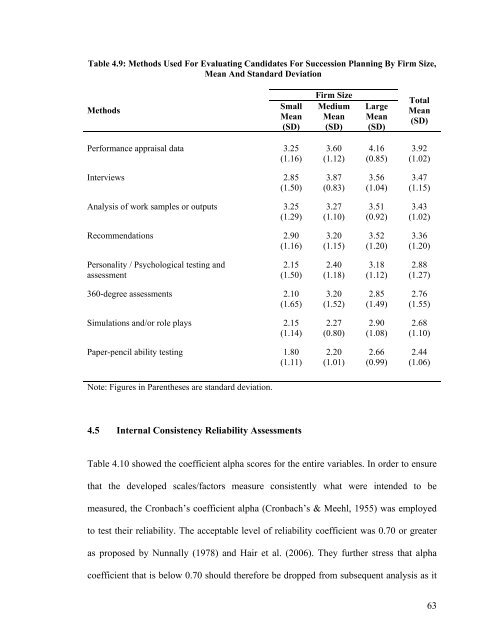CHAPTER 1: INTRODUCTION 1.0 Chapter Overview - DSpace@UM
CHAPTER 1: INTRODUCTION 1.0 Chapter Overview - DSpace@UM
CHAPTER 1: INTRODUCTION 1.0 Chapter Overview - DSpace@UM
You also want an ePaper? Increase the reach of your titles
YUMPU automatically turns print PDFs into web optimized ePapers that Google loves.
Table 4.9: Methods Used For Evaluating Candidates For Succession Planning By Firm Size,Mean And Standard DeviationMethodsSmallMean(SD)Firm SizeMediumMean(SD)LargeMean(SD)TotalMean(SD)Performance appraisal data 3.25(1.16)3.60(1.12)4.16(0.85)3.92(<strong>1.0</strong>2)Interviews 2.85(1.50)3.87(0.83)3.56(<strong>1.0</strong>4)3.47(1.15)Analysis of work samples or outputs 3.25(1.29)3.27(1.10)3.51(0.92)3.43(<strong>1.0</strong>2)Recommendations 2.90(1.16)3.20(1.15)3.52(1.20)3.36(1.20)Personality / Psychological testing andassessment2.15(1.50)2.40(1.18)3.18(1.12)2.88(1.27)360-degree assessments 2.10(1.65)3.20(1.52)2.85(1.49)2.76(1.55)Simulations and/or role plays 2.15(1.14)2.27(0.80)2.90(<strong>1.0</strong>8)2.68(1.10)Paper-pencil ability testing 1.80(1.11)2.20(<strong>1.0</strong>1)2.66(0.99)2.44(<strong>1.0</strong>6)Note: Figures in Parentheses are standard deviation.4.5 Internal Consistency Reliability AssessmentsTable 4.10 showed the coefficient alpha scores for the entire variables. In order to ensurethat the developed scales/factors measure consistently what were intended to bemeasured, the Cronbach’s coefficient alpha (Cronbach’s & Meehl, 1955) was employedto test their reliability. The acceptable level of reliability coefficient was 0.70 or greateras proposed by Nunnally (1978) and Hair et al. (2006). They further stress that alphacoefficient that is below 0.70 should therefore be dropped from subsequent analysis as it63
















